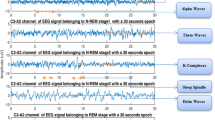Abstract
This paper examines the benefits and shortfalls of using local binary “one-vs.-all” classifiers with a variety of models in different hierarchical layouts in order to classify sleep stages using raw signal inputs in 30-s increments. Although under-performing more advanced algorithms, our best hierarchies outperform a Random Forest multi-class classifier, indicating the potential of binary classifiers in future work. This paper lays the groundwork for developing more advanced hierarchical classifiers using pre-trained binary classifiers.
Access this chapter
Tax calculation will be finalised at checkout
Purchases are for personal use only
Similar content being viewed by others
References
Consequences of insufficient sleep. https://healthysleep.med.harvard.edu/healthy/matters/consequences
Aboalayon, K.A.I., Faezipour, M., Almuhammadi, W.S., Moslehpour, S.: Sleep stage classification using EEG signal analysis: a comprehensive survey and new investigation. Entropy 18(9), 272 (2016)
Bakmeedeniya, T.: Random forest approach for sleep stage classification. 10, 768 (2020). https://doi.org/10.29322/IJSRP.10.05.2020.p10189
CDC: Sleep and sleep disorders. https://www.sleepassociation.org/about-sleep/sleep-statistics/
Chen, Y., Chang, R., Guo, J.: Emotion recognition of EEG signals based on the ensemble learning method: Adaboost. Math. Problems Eng. 2021, 1–12 (2021)
of Communcations, O., Liason, P.: Brain basics: sleep disorders. https://www.ninds.nih.gov/Disorders/Patient-Caregiver-Education/Understanding-Sleep#10
Craik, A., He, Y., Contreras-Vidal, J.L.: Deep learning for electroencephalogram (EEG) classification tasks: a review. J. Neural Eng. 16(3), 031001 (2019)
Dabas, H., Sethi, C., Dua, C., Dalawat, M., Sethia, D.: Emotion classification using EEG signals. In: Proceedings of the 2018 2nd International Conference on Computer Science and Artificial Intelligence, pp. 380–384 (2018)
Eldele, E., et al.: An attention-based deep learning approach for sleep stage classification with single-channel EEG. IEEE Trans. Neural Syst. Rehab. Eng. 29, 809–818 (2021). https://doi.org/10.1109/TNSRE.2021.3076234
Hsu, C.W., Lin, C.J.: A comparison of methods for multiclass support vector machines. IEEE Trans. Neural Netw. 13(2), 415–425 (2002). https://doi.org/10.1109/72.991427
Keenan, S.A.: Polysomnographic technique: an overview. Sleep Disorders Medicine, pp. 79–94 (1994)
Kemp, B., Zwinderman, A., Tuk, B., Kamphuisen, H., Oberye, J.: Analysis of a sleep-dependent neuronal feedback loop: the slow-wave microcontinuity of the EEG. IEEE Trans. Biomed. Eng. 47(9), 1185–1194 (2000). https://doi.org/10.1109/10.867928
McCarley, R.W., Sinton, C.M.: Neurobiology of sleep and wakefulness. Scholarpedia 3(4), 3313 (2008). https://doi.org/10.4249/scholarpedia.3313
Mousavi, S., Afghah, F., Acharya, U.R.: SleepEEGNet: automated sleep stage scoring with sequence to sequence deep learning approach. PloS one 14(5), e0216456 (2019)
Patel, A.K., Reddy, V., Araujo, J.F.: Physiology, Sleep Stages. In: StatPearls [Internet] (2021)
Sha’abani, M.N.A.H., Fuad, N., Jamal, N., Ismail, M.F.: kNN and SVM classification for EEG: a review. In: Kasruddin Nasir, A.N., et al. (eds.) InECCE2019. LNEE, vol. 632, pp. 555–565. Springer, Singapore (2020). https://doi.org/10.1007/978-981-15-2317-5_47
Subasi, A., Ismail Gursoy, M.: EEG signal classification using PCA, ICA, LDA and support vector machines. Expert Syst. Appl. 37(12), 8659–8666 (2010). https://doi.org/10.1016/j.eswa.2010.06.065. https://www.sciencedirect.com/science/article/pii/S0957417410005695
Uzun, S.: Machine learning-based classification of time series of chaotic systems. Eur. Phys. J. Spec. Top. , 1–11 (2021). https://doi.org/10.1140/epjs/s11734-021-00346-z
Vilamala, A., Madsen, K.H., Hansen, L.K.: Deep convolutional neural networks for interpretable analysis of EEG sleep stage scoring. In: 2017 IEEE 27th International Workshop on Machine Learning for Signal Processing (MLSP), pp. 1–6. IEEE (2017)
Author information
Authors and Affiliations
Corresponding author
Editor information
Editors and Affiliations
Rights and permissions
Copyright information
© 2022 Springer Nature Switzerland AG
About this paper
Cite this paper
Oh, E., Barkdoll, K. (2022). Hierarchical Binary Classifiers for Sleep Stage Classification. In: Duffy, V.G., Gao, Q., Zhou, J., Antona, M., Stephanidis, C. (eds) HCI International 2022 – Late Breaking Papers: HCI for Health, Well-being, Universal Access and Healthy Aging. HCII 2022. Lecture Notes in Computer Science, vol 13521. Springer, Cham. https://doi.org/10.1007/978-3-031-17902-0_9
Download citation
DOI: https://doi.org/10.1007/978-3-031-17902-0_9
Published:
Publisher Name: Springer, Cham
Print ISBN: 978-3-031-17901-3
Online ISBN: 978-3-031-17902-0
eBook Packages: Computer ScienceComputer Science (R0)




